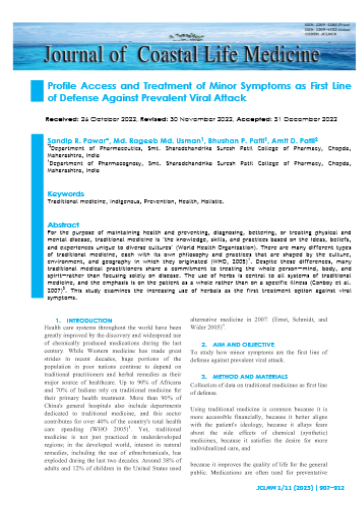Profile Access and Treatment of Minor Symptoms as First Line of Defense Against Prevalent Viral Attack
Main Article Content
Abstract
For the purpose of maintaining health and preventing, diagnosing, bettering, or treating physical and mental disease, traditional medicine is "the knowledge, skills, and practices based on the ideas, beliefs, and experiences unique to diverse cultures" (World Health Organization). There are many different types of traditional medicine, each with its own philosophy and practices that are shaped by the culture, environment, and geography in which they originated (WHO, 2005)1. Despite these differences, many traditional medical practitioners share a commitment to treating the whole person—mind, body, and spirit—rather than focusing solely on disease. The use of herbs is central to all systems of traditional medicine, and the emphasis is on the patient as a whole rather than on a specific illness (Conboy et al. 2007)2. This study examines the increasing use of herbals as the first treatment option against viral symptoms.
Article Details
References
World Health Organization (WHO). National Policy on Traditional Medicine and Regulation of Herbal Medicines. Geneva: 2005. Report of WHO global survey.
Conboy L, Kaptchuk T. J, Eisenberg D. M, Gottlieb B, Acevedo-Garcia D. The relationship between social factors and attitudes toward conventional and CAM practitioners. Complement TherClinPract. 2007;13:146–57.
Calapai G. European legislation on herbal medicines: A look into the future; 2008: Vol. 31: 428–31.
Ernst E, Schmidt K, Wider B. CAM research in Britain: The last 10 years. Complement TherClinPract. 2005;11:17–20.
Loya A. M, Gonzalez-Stuart A, Rivera J. O. Prevalence of polypharmacy, polyherbacy, nutritional supplement use and potential product interactions among older adults living on the United States-Mexico border: A descriptive, questionnaire-based study. Drugs Aging. 2009;26:423–36.
Cohen P. A, Ernst E. Safety of herbal supplements: A guide for cardiologists. Cardiovasc Ther. 2010;28:246–53.
Eisenberg D. M, Davis R. B, Ettner S. L, Appel S, Wilkey S, Van Rompay M, Kessler R. C. Trends in alternative medicine use in the United States, 1990-1997: Results of a follow-up national survey. JAMA. 1998;280:1569–75.
Engebretson J. Culture and complementary therapies. Complement TherNurs Midwifery. 2002;8:177–84.
Food and Drug Administration (FDA). 2010. Overview of dietary supplements. website: www.fda.gov/food/dietarysupplements/consumerinformation (accessed November 5, 2010)
Li J. W. H, Vederas J. C. Drug discovery and natural products: End of an era or an endless frontier? Science. 2009;325:161–5.
Sahoo N, Manchikanti P, Dey S. Herbal drugs: Standards and regulation. Fitoterapia. 2010;81(6):462–71.
Tilburt J. C, Kaptchuk T. J. J. Herbal medicine research and global health: An ethical analysis. Bull World Health Organ. 2008;86(8):594–9.
World Health Organization (WHO). “Traditional Medicine.” http://www.who.int/topics/traditional_medicine/en/ (accessed July 21, 2010)

